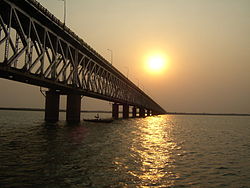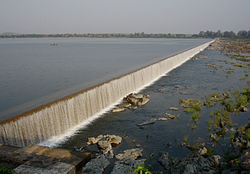Specifications
The twin arches, box girders, struts are all made of prestressed concrete.
The twin arches have a constant width of 0.8 metres (2 ft 7 in) and depth varying from 1.7 metres (5 ft 7 in) at the springing to 1.1 metres (3 ft 7 in) at the crown. These are connected laterally with struts (known as Vierendeel truss) and box girder.
There are 28 identical spans of twin arches, of parabolic profile, spaced at 5.6 metres (18 ft), each of 97 metres (318 ft) width from centre to centre of the piers with a total length of 2.7 kilometres (1.7 mi). [3]
The effective span from centre to centre of the bearings is 94 metres (308 ft). [5]
Each girder is 95.552 metres (313.49 ft) long.
The final dimensions of the box girder are 95.462 metres (313.20 ft)×5,200 millimetres (200 in) (bottom) with thickness of the top slab of 296 millimetres (11.7 in), the web of 300 millimetres (12 in) thickness and with the bottom slab thickness kept at 240 millimetres (9.4 in).A diaphragm stiffens the box girder at each Dina Hanger location. [6]
The substructure of the bridge consists of 28 piers. [7]
Design aspects
The superstructure of the bridge is of the bow-string girder type. While designing, the projected speed for the trains was taken as 160 km per hour. Taking into consideration the cyclonic conditions, the wind speed considered without live load was 200 kilometres (120 mi) per hour, and with dead load the speed considered was 158 kilometres (98 mi) per hour. As the location of the bridge is in the Seismic Zone I, seismic load has not been accounted for in the design.
The bridge is designed to run trains at a speed of 160 miles (260 km) per hour and is designed to withstand wind speed of 200 miles (320 km) per hour during cyclonic storms that are anticipated in and around Rajahmundry. [5]
Arches
The arches are designed to share 80% of the dead load and live load transferred from the hangers and thus a plays a critical role of relieving the flexural and shear stresses on the girder. Twelve sinking supports are provided at each hanger location connecting with the girder. [6]
Hangers
Each span of the bridge has 24 hangers, which are further divided into six types depending on their length. Each Dina Hanger is made of 49 high tensile steel wires of 7 millimetres (0.28 in) diameter each. These wires run parallel to each other and are encased in a high tensile polythene pipe, which is cement grouted. [8]
Girders
The box girders are made of M42 grade concrete. Each girder was prestressed with 16 longitudinal cables, which in turn were prestressed to a force of 2950 kN each. [1]
The box girder, which functions as the deck of the bridge and carries the live load, comprises end diaphragm (1,000 millimetres (39 in) thick), which has inspection windows. [9]
The design of the girder accounts for loading conditions of full span train load, half span train load, one third span train load and so forth with due accounting of temperature variation of ±10 °C (50 °F). At each stage of casting of the girders (seven stages of casting were involved for each girder from girder stressing to removal of form work) forces generated in the arch section were studied and accounted. The girder casting also ensured that no cracks appeared in the arches at any stage. [10]
Bearings
The bridge has been provided with pot bearings, of 1050 tonnes capacity. One each pier, the girder is supported on four pot bearings of three types: PNa, PNe, PN.
The PNa type bearing (which facilitates free sliding in both directions) on one pier and PNe type (slides only in one direction) in the succeeding pier and PN type which is fixed type.
The PNa and PNe type of bearings have been pre-set for 60 millimetres (2.4 in) movement in the longitudinal direction and 10 millimetres (0.39 in) in the lateral direction and the centre line of top plate has been fixed relatively by 60 millimetres (2.4 in)/10 millimetres (0.39 in) with respect to centre line of bottom plate of the bearing which will permit the movements due to creep, shrinkage and elastic deformation. [7] Their placement ensures that only longitudinal movement takes place without permitting any lateral moment. [11]
Three sets of bearings were imported from Switzerland, while the balance bearings were made by BBR (India) Pvt Ltd, India. [1]







